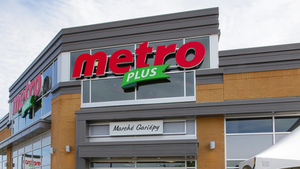ETHNIC MARKETING GAINING A FOLLOWING
CHICAGO -- Finast-Ohio, a chain based in Maple Heights, Ohio, increased its customer base and generated substantial incremental sales at 11 new and remodeled stores by tailoring programs to minorities in the market, an executive of the retailer said.Henry Edwards, Finast's vice president of human resources, spoke about the chain's improved sales performance at the Food Marketing Institute's annual
May 16, 1994
JOEL ELSON
CHICAGO -- Finast-Ohio, a chain based in Maple Heights, Ohio, increased its customer base and generated substantial incremental sales at 11 new and remodeled stores by tailoring programs to minorities in the market, an executive of the retailer said.
Henry Edwards, Finast's vice president of human resources, spoke about the chain's improved sales performance at the Food Marketing Institute's annual convention and educational exposition here. He spoke at the workshop, "Successful Segment Marketing Techniques for Minority Consumer Groups."
Edwards said that before Finast implemented its minority marketing programs, it considered but did not follow the industry maxim that says, "One-size-fits-all is the efficient approach to doing business." This strategy is not the most effective for capturing a fair share of the multicultural market, Edwards said.
"The companies that will be successful in addressing multicultural markets will be those who are committed to continuous learning and who approach this marketing and operational initiative in the manner that [they] approach new technology and other ways to take costs out of the business," he said.
Finast invested $40 million over four and a half years to develop its minority marketing program, Edwards said. Four new stores were built and seven units were remodeled or enlarged, Edwards told SN after his workshop address.
Finast is a division of Ahold USA, Parsippany, N.J.
Although Finast has operated urban stores for a number of years, the chain is continually researching, adjusting and rearranging its programs, Edwards said.
William MacAloney, president and chief executive officer of Jax Markets, Anaheim, Calif., said preferences and shopping patterns of U.S. consumers will continue to evolve as the population becomes more diverse. MacAloney spoke at the same workshop.
He said the primary implication for retailers and wholesalers is that "mass marketing is no longer going to be the best strategy for all products and in all markets."
Consumers want to purchase products that meet their needs, MacAloney said. "That's the easy part. The hard part is figuring out how best to meet the wide variety of customers' needs as the demographics in our marketplace continue to evolve." Gary Berman, president of Market Segment Research, Coral Gables, Fla., another workshop panelist, told retailers and wholesalers to avoid stereotyping Hispanic shoppers in their marketing plans. Even within the Hispanic population, there are marketing niches for retailers to target, Berman said.
"It's widely known Hispanics eat a lot of beans, [but] you have to target-market," he said. "Cubans eat black beans, Puerto Ricans prefer red beans and Mexicans eat refried beans."
Charles Morrison, president of Morrison Group, Atlanta, told the workshop attendees that "ethnic marketing means real volume and share growth for savvy retailers and marketers." McDonald's cashed in on this idea when years ago its management recognized that blacks and Hispanics were among the most frequent consumers of fast food.
Morrison said food retailers and marketers have been particularly slow to respond to these opportunities. "Many people blame this on an outdated mass-market mentality from which food retailers and marketers are slowing moving away," he said. However, chains such as Kroger Co., Cincinnati; Pathmark Stores, Woodbridge, N.J., Finast and some others have "learned who their ethnic customers are, found out what they want and have done a good job in catering to their wants," he said.
About the Author
You May Also Like




